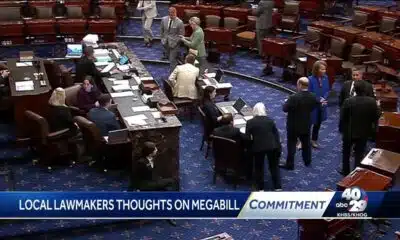News from the South - Arkansas News Feed
Arkansas Supreme Court chief justice harassed court staff, per HR report filed in ongoing litigation
UPDATED: Arkansas Supreme Court chief justice harassed court staff, per human resources report
by Tess Vrbin, Arkansas Advocate
March 13, 2025
Editor’s note: This story was updated at 4:25 p.m. on March 13, 2025, to clarify whose emails Justice Hudson filed into evidence in a 2024 lawsuit, and again at 5:05 p.m. to include the Supreme Court’s latest per curiam order and Tom Mars’ motion for Justice Wood to recuse herself from ongoing litigation.
A report made public Thursday asserts that Arkansas Supreme Court Justice Karen Baker harassed judiciary employees on Dec. 4-5, 2024, after she was elected but before she was sworn in as the first elected female chief justice.
“Justice Baker intimidated staff, appears to have targeted female employees of color, indicated an intention to retaliate based on her perception of how employees voted, and indicated an intention to retaliate based on her perception of whether employees were cooperating with Judicial Discipline and Disability Commission’s investigation into her colleague’s conduct,” the report from the Administrative Office of the Courts human resources department states.
Baker’s behavior violated the AOC’s anti-harassment policy, according to the Jan. 10 report. The policy states in part: “Harassment undermines the integrity of the judiciary and violates the standard professional working environment to which employees are entitled… In particular, discrimination based on disability, color, gender, national origin, race, religion, or sex is strictly prohibited.”
AOC Director Marty Sullivan asked Baker on Jan. 13 to stay away from the agency’s offices and not to communicate with his staff, pending the conclusion of a Judicial Discipline and Disability Commission (JDDC) review against her. This disciplinary action is outlined in the report’s conclusion.
“If the perpetrator was under the authority of the AOC, HR would likely recommend termination or other serious disciplinary measures,” the report states. “Nevertheless, the AOC has an obligation to protect employees from further harassment.”
The filing of the report is the latest development in an ongoing dispute between Baker and most of her colleagues since she became chief justice Jan. 1. Previously, five of the other six justices blocked Baker’s attempts to fire 10 judiciary employees, including Sullivan, and appoint three new judges to the JDDC within three days of taking the oath of office. The JDDC investigates complaints about the conduct of judges and the justices.
The five justices stated in their per curiam orders that Baker was acting beyond the scope of her new authority. Baker has repeatedly maintained that state law and the state Constitution give the chief justice the authority to act unilaterally in personnel and appointment matters.
Associate Justice Courtney Hudson did not participate in the orders blocking Baker’s actions. She and Baker also did not participate in a March 6 order requiring Baker to file the HR report with the court by Tuesday nor in a Thursday morning order that allowed the release of a redacted version of the HR report.
Associate Justice Cody Hiland also did not participate in Thursday’s initial order or the following per curiam order reiterating the court’s stance that the HR report should be made public with redactions.
The March 6 order as well as Thursday’s resulted from an administrative civil appeal Baker filed Jan. 23 against Sullivan. In that filing, her attorney, Tom Mars, asked the high court to dismiss Sullivan’s “findings and recommendations” from the human resources investigation.
Five justices said in the March 6 order that Baker’s claim of visiting the Justice Building for “completely legitimate reasons” in December was “impossible” to verify without the HR report. The report submitted Monday was initially sealed because it pertained to allegations that the high court had not ruled on, Supreme Court Clerk Kyle Burton said Tuesday.
Attorney General Tim Griffin’s office, representing Sullivan, asked the Supreme Court on Tuesday to deny Baker’s request to keep the document sealed. Monday’s submission included “additional factual allegations or characterizations related to the AOC investigation and report” that did not belong in the filing, according to Griffin’s office.
Mars filed a motion on Wednesday to withdraw Baker’s initial petition to the court. The motion alleges that Sullivan “decided to invent” AOC’s anti-harassment policy “out of whole cloth” shortly before completing the human resources report.
Sullivan declined to comment on the report, and Mars did not comment Thursday afternoon before publication.
Later Thursday afternoon, Mars filed a motion urging Associate Justice Rhonda Wood to recuse herself from the case. He cited Wood’s statement that “Marty Sullivan is the most amazing man on Earth” and that Baker should apologize to Sullivan during a rare public Supreme Court business meeting on Jan. 23, in which Wood and other justices were critical of Baker’s actions since becoming chief justice.
Mars said this indicated bias on Wood’s part, in addition to the fact that Wood was Baker’s opponent for the chief justice position in last year’s election that went to a runoff.
“Human nature being what it is, it would be surprising if Justice Wood did not hold at least somewhat of a grudge,” Mars wrote.
The allegations
The human resources document corroborates reports that Baker entered Sullivan’s office on Dec. 4 when he was not present. She “was observed looking throughout Mr. Sullivan’s office, including the area behind his desk” and later returned with two other people.
Their names are redacted in the document, but surveillance footage obtained via the state’s public records law and reported in December by Arkansas Business showed that Baker’s former law clerk, Department of Commerce Chief of Staff Allison Hatfield, and Hudson were the chief justice-elect’s two companions.
A court employee who saw the trio at Sullivan’s office Dec. 4 “had the distinct impression that the two [others] were purposefully distracting the employee and blocking the view,” the report states.
Baker then visited AOC’s Court Information Systems Division, where she told an employee who didn’t recognize her that the individual must not have voted for her, or voted at all, in November, the report states. The individual was one of two employees who reported feeling harassed by Baker approaching them, and witnesses corroborated their accounts, according to the HR report.
“The employees realized that Justice Baker had spoken only with employees of color and skipped the many white employees,” the report states. “The employees reported feeling targeted by Justice Baker because of the employees’ race.”
Baker also asked another Court Information Systems Division employee for information that the employee did not provide, responding with “That’s all I need to know” when the person hesitated, according to the report.
Justice Baker intimidated staff… and indicated an intention to retaliate based on her perception of whether employees were cooperating with Judicial Discipline and Disability Commission’s investigation into her colleague’s conduct.
– A report from the Administrative Office of the Courts human resources department
Court Information Systems Division director Tim Holthoff and deputy director Cecil Davis were among the 10 judiciary employees Baker attempted to fire in January. So was Pete Hollingsworth, chief of the Supreme Court Police Department, which received a complaint from a court employee who saw Baker, Hudson and Hatfield in AOC’s administrative suite, according to the report.
In the Jan. 3 order blocking the firings, Baker and Hudson’s colleagues called the firings “retaliatory.” On Jan. 2, Baker “confronted” Sullivan and Hollingsworth “about their responses to Freedom of Information Act requests involving her,” according to the order. The Court Information Systems Division is also involved in AOC’s responses to FOIA requests.
Baker returned to AOC’s administrative suite Dec. 5 and tried to order one of the employees she approached the previous day to let her into Sullivan’s locked office. The employee “was visibly shaken and appeared to feel humiliated by Justice Baker’s actions toward her,” the report states.
Upon learning another employee had been instructed not to unlock Sullivan’s office, Baker said “things would be changing come January.”
Disputes over JDDC
On Jan. 8, Baker issued an opinion declaring invalid her colleagues’ orders blocking her attempted AOC firings and JDDC appointments. The other justices, with the exception of Hudson, issued a statement saying Baker’s “later-filed dissent” from their two orders “has no legal effect beyond that of a dissenting opinion.”
Baker spent more than an hour fielding questions from the other justices about her behavior in the Jan. 23 Supreme Court business meeting, the same day she filed the civil appeal against Sullivan.
Associate Justice Shawn Womack said at the meeting that the court attempted to make new appointments to JDDC late last year, but the effort was delayed, including by Baker.
Womack asked Baker if she “intentionally” tried to “get control of the commission that was investigating” her as soon as she became chief justice. Baker said she was not the only justice under investigation and did not respond further to the question.
Circuit Judge H.G. Foster of Conway, the judge who swore in Baker as chief justice at midnight on Jan. 1, was one of the three blocked JDDC appointees. Before 12:30 a.m., Baker drew up the appointment orders for Foster and two other judges, one of whom had just retired from the bench. JDDC members are required to be sitting judges.
The human resources report specifies that Baker “indicated an intention to retaliate” against court employees based on whether they were cooperating with a JDDC “investigation into her colleague’s conduct.”
Five justices referred Hudson to the disciplinary panel in September 2024 for “flagrant breaches of confidentiality” after she filed former Chief Justice John Dan Kemp’s emails into evidence in her attempt to block the release of emails between her, Hatfield and others in response to a FOIA request from Arkansas Business. Kemp, Baker’s predecessor, did not run for reelection last year.
Baker wrote in her dissent that the majority had “a fundamental misunderstanding” of the FOIA and had damaged the Supreme Court’s credibility. She made transparency a focus of her successful runoff campaign against Wood.
The JDDC gave notice last week that it will hold a special meeting Friday at 10:30 a.m.
Arkansas Advocate is part of States Newsroom, a nonprofit news network supported by grants and a coalition of donors as a 501c(3) public charity. Arkansas Advocate maintains editorial independence. Contact Editor Sonny Albarado for questions: info@arkansasadvocate.com.
The post Arkansas Supreme Court chief justice harassed court staff, per HR report filed in ongoing litigation appeared first on arkansasadvocate.com
News from the South - Arkansas News Feed
Local Party Leaders Response to Trump's Bill
SUMMARY: Local party leaders in Arkansas express divided views on Trump’s bill advancing narrowly in the Senate. Republican Senator Bart Hester praises its progress, highlighting tax cuts and protections for Medicaid and SNAP benefits for vulnerable populations. In contrast, Arkansas Democratic Party’s Micah Wallace criticizes the bill for creating obstacles to healthcare and calls the slim margin a reflection of electoral stakes. Governor Sarah Huckabee Sanders supports the bill overall but opposes the AI regulation section, which she says undermines state powers to control AI misuse. Leaders agree the bill holds significant consequences amid ongoing national debate.
Leaders in the Natural State speak out about the progress of President Trump’s “big, beautiful bill.”
Subscribe to 40/29 on YouTube now for more: http://bit.ly/PTElbK
Get more Northwest Arkansas news: http://www.4029tv.com
Like us: http://facebook.com/4029news
Follow us: http://twitter.com/4029news
Instagram: https://www.instagram.com/4029news/
News from the South - Arkansas News Feed
Thousands celebrate pride, progress at the 2025 NWA Pride Parade
SUMMARY: Thousands gathered in Fayetteville for the 21st annual Northwest Arkansas Pride Parade, celebrating LGBTQ+ identity and progress. The lively event featured rainbow flags, costumes, signs, and dancing alongside colorful floats on Dickson Street. Attendees emphasized community support and the importance of being true to oneself. Nearby, the Tyson Main Stage hosted entertainment including local DJs, drag performers, and a concert by international pop star Betty Who, marking her Arkansas debut. The parade also commemorated ten years of marriage equality nationwide, with many honoring the milestone while advocating for continued progress and awareness of ongoing challenges faced by LGBTQ+ individuals.
Thousands celebrate pride, progress at the 2025 NWA Pride Parade
Subscribe to 40/29 on YouTube now for more: http://bit.ly/PTElbK
Get more Northwest Arkansas news: http://www.4029tv.com
Like us: http://facebook.com/4029news
Follow us: http://twitter.com/4029news
Instagram: https://www.instagram.com/4029news/
News from the South - Arkansas News Feed
Congress unlikely to enact ‘absolutely devastating’ Trump proposal to slash Pell Grants
by Shauneen Miranda, Arkansas Advocate
June 29, 2025
WASHINGTON — President Donald Trump wants to cut nearly $1,700 from the maximum Pell Grant award as part of his fiscal 2026 budget request — a move that would leave the subsidy for low-income students at its lowest level in more than a decade.
The proposal would have a devastating effect on college affordability and drive up costs for states because they’d have to fill in the missing federal dollars, education advocates and experts say.
The request — part of the president’s wish list for appropriations in fiscal 2026 — faces steep odds in Congress, where key members of both parties responded to the proposal with alarm.
“I don’t want to cut the Pell Grant,” U.S. Sen. Shelley Moore Capito, a West Virginia Republican and chair of the Senate Appropriations Subcommittee on Labor, Health and Human Services, Education, and Related Agencies, told States Newsroom.
“I’m concerned about that — I’m hoping that we’ll get that resolved,” she said.
Opposition from Capito, whose panel writes the annual bill to fund the Education Department, makes Trump’s wish unlikely to make its way into the upcoming legislation.
The Pell Grant is a government subsidy that helps low-income students pay for college and is the foundation of federal student aid in the United States.
Catherine Brown, senior policy and advocacy director at the National College Attainment Network, said the cut would be “absolutely devastating,” noting that “college is already out of reach for millions upon millions of low-income students.”
Funding gap
The Pell Grant program is seeing a projected budget shortfall of $2.7 billion heading into the next fiscal year, according to the nonpartisan Congressional Budget Office. The administration has cited the shortfall as a reason to decrease the maximum award.
The request calls for reducing the maximum Pell Grant for the 2026-2027 award year from $7,395 to $5,710. The last time the maximum award stood below this level was during the 2013-2014 award year, at $5,645.
Trump’s fiscal 2026 budget request includes $12 billion in total cuts to the Education Department as he and his administration seek to dismantle the agency and dramatically reshape the federal role in education.
Democrats: Cut would be ‘crazy’
Democrats have raised strong opposition, while even the Republican chair of the House Appropriations subcommittee that oversees Education Department funding was noncommittal about pursuing Pell Grant cuts.
“We want to make sure that (Pell Grants are) serving the people they need to,” Rep. Robert Aderholt of Alabama said when asked about any concerns he has on the proposed cut.
Aderholt said he’s hearing “a lot” from his constituents about the proposed reduction, and that it’s “certainly something we’re going to look at.”
Meanwhile, the leading Democrats on the House and Senate education spending panels were quick to blast the proposed cut.
Rep. Rosa DeLauro, ranking member of the full House Appropriations Committee and the education spending subcommittee, called the nearly $1,700 reduction “crazy.”
“People are not going to be able to do it, and that’s the tragedy of what they’re doing here is dismantling all of the constructs that are there to provide people particularly with public education and a pathway to success,” the Connecticut Democrat said.
“You take away Federal Work-Study, you lower the Pell Grant, that says to me, you want to destroy public education,” DeLauro said.
The budget request proposes slashing $980 million of Federal Work-Study funding and requiring employers to pay 75% of students’ hourly wages, with the government contributing 25%.
The program gives part-time employment to students with financial need in order to help cover the cost of college.
Sen. Tammy Baldwin, ranking member of the Senate subcommittee, said she “strongly” opposes the proposed reduction.
The Wisconsin Democrat said she also recognizes that “there’s a looming shortfall in Pell funding that we need to address.”
“I am hopeful that we’ll be able to work together to do that,” Baldwin said.
Advocates, experts weigh in
Higher education advocates and experts are also sounding the alarm on the proposed reduction, both over the harm to low-income students’ access to higher education and the impact on states and colleges.
“This would just much further exacerbate that gap and drive millions of students out of pursuing post-secondary education or set them on a different path,” Brown, with the National College Attainment Network, said.
Katharine Meyer, a governance studies fellow at the Brown Center on Education Policy at the nonpartisan Brookings Institution, described the proposed decline as “truly unprecedented.”
She added that when the Pell Grant is smaller, states have to spend more on higher education, creating a challenge for state officials potentially grappling with other cuts in federal support in the budget reconciliation package Republicans are scrambling to pass.
“States don’t necessarily have the flexibility to spend more money when they have budgets that they need to balance, and they’re facing other federal constraints, including potentially having to take on additional health care costs depending on what happens with health care negotiations in budget reconciliation,” she said.
Capito also said she thought a reduction to Pell Grants would ripple out to the state level.
At the institutional level, Meyer pointed out that if a state has a smaller bucket to allocate for higher education but wants to prioritize financial aid, it would “come at the cost of” the money appropriated to universities.
“Then institutions are not going to be able to spend as much on their operating funds,” she said. “They’re not going to be able to do capital improvement campaigns, which are often very necessary.”
Ties to reconciliation bill
House Republicans have also proposed major changes to Pell Grant eligibility as part of GOP lawmakers’ separate “big, beautiful bill.” The legislative package would slash billions of dollars in federal programs to offset the cost of other parts of Trump’s agenda, including extending the 2017 tax cuts and boosting border security funding.
GOP lawmakers are using the complex reconciliation process to move a package through Congress with simple majority votes in each chamber and avoid the Senate’s 60-vote threshold that generally requires bipartisanship.
The House narrowly passed its version of the reconciliation package in late May. That measure included a provision that would raise the minimum number of credit hours to qualify for the maximum Pell Grant award from 12 per semester to 15. The move would save $7.1 billion in federal spending over 10 years, the Congressional Budget Office estimated.
That new eligibility requirement is not included in the draft proposal for the reconciliation package that Republicans on the Senate Committee on Health, Education, Labor and Pensions released in June.
Arkansas Advocate is part of States Newsroom, a nonprofit news network supported by grants and a coalition of donors as a 501c(3) public charity. Arkansas Advocate maintains editorial independence. Contact Editor Sonny Albarado for questions: info@arkansasadvocate.com.
The post Congress unlikely to enact ‘absolutely devastating’ Trump proposal to slash Pell Grants appeared first on arkansasadvocate.com
Note: The following A.I. based commentary is not part of the original article, reproduced above, but is offered in the hopes that it will promote greater media literacy and critical thinking, by making any potential bias more visible to the reader –Staff Editor.
Political Bias Rating: Center-Left
This content leans center-left as it presents a critical view of proposed budget cuts from the Trump administration, highlighting potential negative impacts on low-income students and public education. It features voices mainly opposing the cuts, including Democrats and education advocates, emphasizing concerns about affordability and access to higher education. However, it maintains a relatively balanced tone by including some Republican opposition and contextual information, avoiding strong partisan language or overt ideological framing.
-
News from the South - Tennessee News Feed6 days ago
Thieves take thousands of dollars in equipment from Union County Soccer League
-
Mississippi Today4 days ago
Defendant in auditor’s ‘second largest’ embezzlement case in history goes free
-
News from the South - Texas News Feed6 days ago
Robert Nichols to retire from Texas Senate
-
News from the South - Louisiana News Feed6 days ago
3 lawsuits filed against CVS, Louisiana AG announces
-
News from the South - Texas News Feed7 days ago
ACLU, student group to sue Texas over expansive 'parental rights' bill
-
News from the South - Missouri News Feed5 days ago
Residents provide feedback in Kearney Street Corridor redevelopment meeting
-
News from the South - Alabama News Feed6 days ago
News 5 NOW at 12:30pm | June 24, 2025
-
News from the South - Alabama News Feed7 days ago
New Spring Hill hotel would replace former armory









































